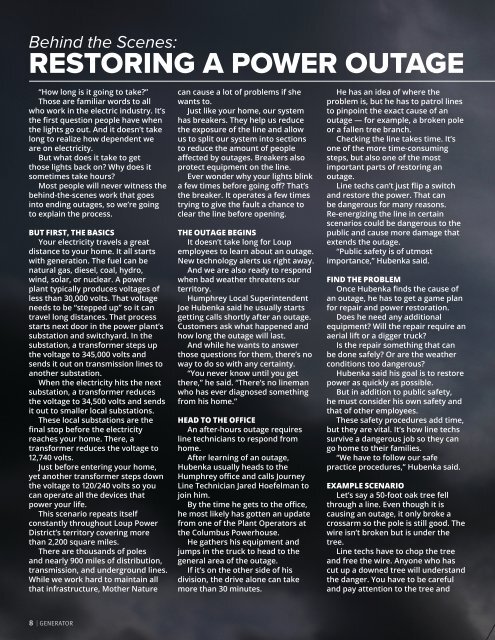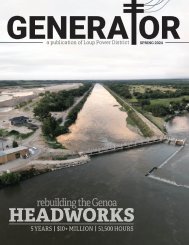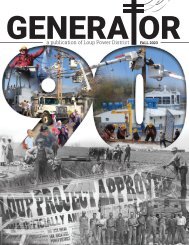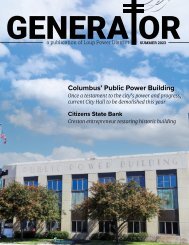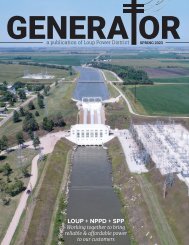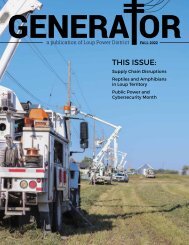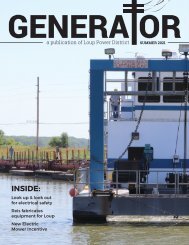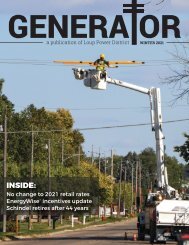Winter 2024 Generator
Topics in this issue include a 2024 rate increase, a lineman's perspective on the power restoration, and 2024 EnergyWise incentives.
Topics in this issue include a 2024 rate increase, a lineman's perspective on the power restoration, and 2024 EnergyWise incentives.
Create successful ePaper yourself
Turn your PDF publications into a flip-book with our unique Google optimized e-Paper software.
Behind the Scenes:<br />
RESTORING A POWER OUTAGE<br />
“How long is it going to take?”<br />
Those are familiar words to all<br />
who work in the electric industry. It’s<br />
the first question people have when<br />
the lights go out. And it doesn’t take<br />
long to realize how dependent we<br />
are on electricity.<br />
But what does it take to get<br />
those lights back on? Why does it<br />
sometimes take hours?<br />
Most people will never witness the<br />
behind-the-scenes work that goes<br />
into ending outages, so we’re going<br />
to explain the process.<br />
BUT FIRST, THE BASICS<br />
Your electricity travels a great<br />
distance to your home. It all starts<br />
with generation. The fuel can be<br />
natural gas, diesel, coal, hydro,<br />
wind, solar, or nuclear. A power<br />
plant typically produces voltages of<br />
less than 30,000 volts. That voltage<br />
needs to be “stepped up” so it can<br />
travel long distances. That process<br />
starts next door in the power plant’s<br />
substation and switchyard. In the<br />
substation, a transformer steps up<br />
the voltage to 345,000 volts and<br />
sends it out on transmission lines to<br />
another substation.<br />
When the electricity hits the next<br />
substation, a transformer reduces<br />
the voltage to 34,500 volts and sends<br />
it out to smaller local substations.<br />
These local substations are the<br />
final stop before the electricity<br />
reaches your home. There, a<br />
transformer reduces the voltage to<br />
12,740 volts.<br />
Just before entering your home,<br />
yet another transformer steps down<br />
the voltage to 120/240 volts so you<br />
can operate all the devices that<br />
power your life.<br />
This scenario repeats itself<br />
constantly throughout Loup Power<br />
District’s territory covering more<br />
than 2,200 square miles.<br />
There are thousands of poles<br />
and nearly 900 miles of distribution,<br />
transmission, and underground lines.<br />
While we work hard to maintain all<br />
that infrastructure, Mother Nature<br />
can cause a lot of problems if she<br />
wants to.<br />
Just like your home, our system<br />
has breakers. They help us reduce<br />
the exposure of the line and allow<br />
us to split our system into sections<br />
to reduce the amount of people<br />
affected by outages. Breakers also<br />
protect equipment on the line.<br />
Ever wonder why your lights blink<br />
a few times before going off? That’s<br />
the breaker. It operates a few times<br />
trying to give the fault a chance to<br />
clear the line before opening.<br />
THE OUTAGE BEGINS<br />
It doesn’t take long for Loup<br />
employees to learn about an outage.<br />
New technology alerts us right away.<br />
And we are also ready to respond<br />
when bad weather threatens our<br />
territory.<br />
Humphrey Local Superintendent<br />
Joe Hubenka said he usually starts<br />
getting calls shortly after an outage.<br />
Customers ask what happened and<br />
how long the outage will last.<br />
And while he wants to answer<br />
those questions for them, there’s no<br />
way to do so with any certainty.<br />
“You never know until you get<br />
there,” he said. “There’s no lineman<br />
who has ever diagnosed something<br />
from his home.”<br />
HEAD TO THE OFFICE<br />
An after-hours outage requires<br />
line technicians to respond from<br />
home.<br />
After learning of an outage,<br />
Hubenka usually heads to the<br />
Humphrey office and calls Journey<br />
Line Technician Jared Hoefelman to<br />
join him.<br />
By the time he gets to the office,<br />
he most likely has gotten an update<br />
from one of the Plant Operators at<br />
the Columbus Powerhouse.<br />
He gathers his equipment and<br />
jumps in the truck to head to the<br />
general area of the outage.<br />
If it’s on the other side of his<br />
division, the drive alone can take<br />
more than 30 minutes.<br />
He has an idea of where the<br />
problem is, but he has to patrol lines<br />
to pinpoint the exact cause of an<br />
outage — for example, a broken pole<br />
or a fallen tree branch.<br />
Checking the line takes time. It’s<br />
one of the more time-consuming<br />
steps, but also one of the most<br />
important parts of restoring an<br />
outage.<br />
Line techs can’t just flip a switch<br />
and restore the power. That can<br />
be dangerous for many reasons.<br />
Re-energizing the line in certain<br />
scenarios could be dangerous to the<br />
public and cause more damage that<br />
extends the outage.<br />
“Public safety is of utmost<br />
importance,” Hubenka said.<br />
FIND THE PROBLEM<br />
Once Hubenka finds the cause of<br />
an outage, he has to get a game plan<br />
for repair and power restoration.<br />
Does he need any additional<br />
equipment? Will the repair require an<br />
aerial lift or a digger truck?<br />
Is the repair something that can<br />
be done safely? Or are the weather<br />
conditions too dangerous?<br />
Hubenka said his goal is to restore<br />
power as quickly as possible.<br />
But in addition to public safety,<br />
he must consider his own safety and<br />
that of other employees.<br />
These safety procedures add time,<br />
but they are vital. It’s how line techs<br />
survive a dangerous job so they can<br />
go home to their families.<br />
“We have to follow our safe<br />
practice procedures,” Hubenka said.<br />
EXAMPLE SCENARIO<br />
Let’s say a 50-foot oak tree fell<br />
through a line. Even though it is<br />
causing an outage, it only broke a<br />
crossarm so the pole is still good. The<br />
wire isn’t broken but is under the<br />
tree.<br />
Line techs have to chop the tree<br />
and free the wire. Anyone who has<br />
cut up a downed tree will understand<br />
the danger. You have to be careful<br />
and pay attention to the tree and<br />
8 | GENERATOR


